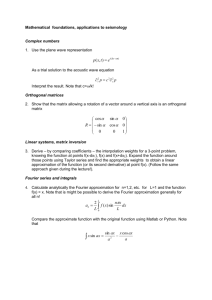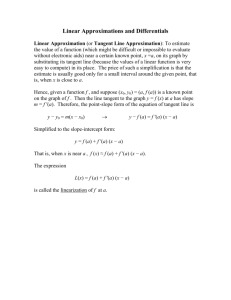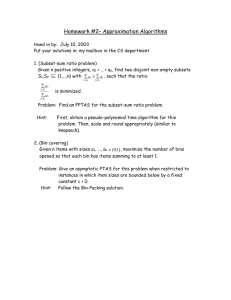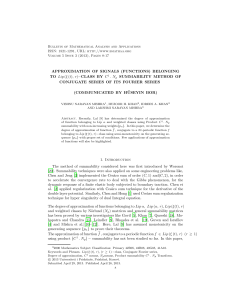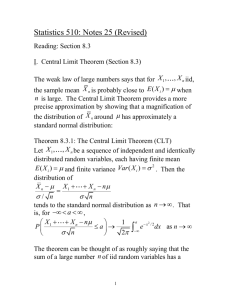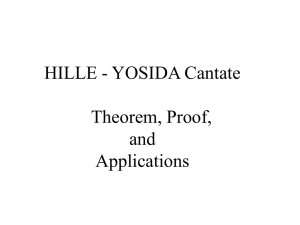On Degree of approximation by Product Means of the
advertisement
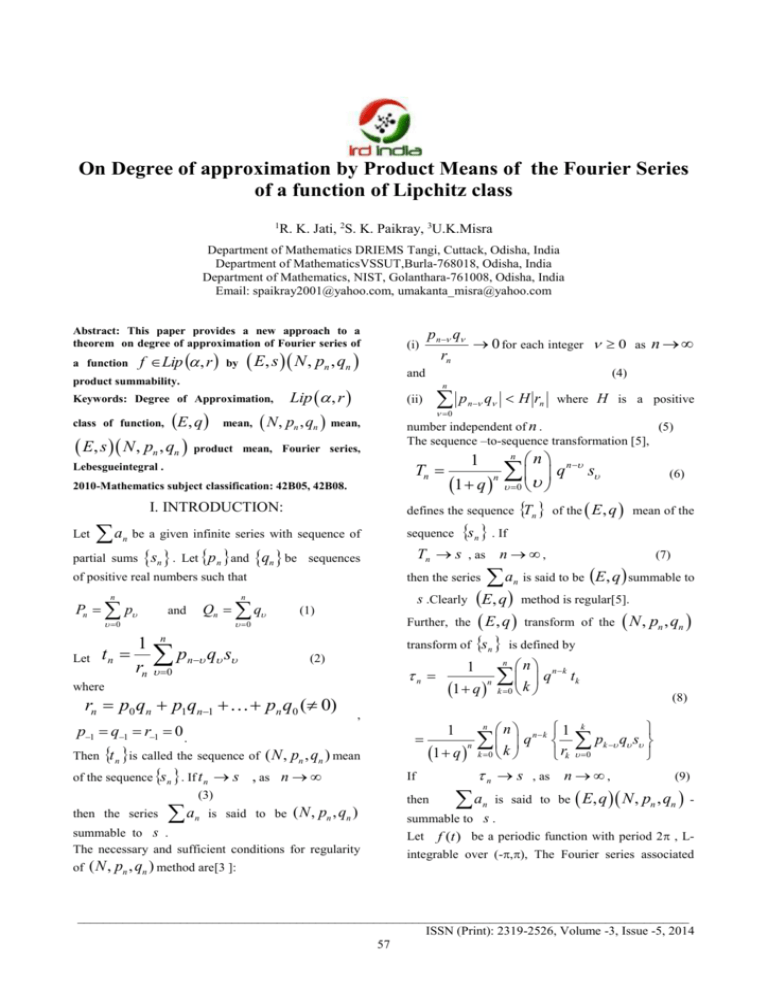
International Journal on Advanced Computer Theory and Engineering (IJACTE) ________________________________________________________________________________________________ On Degree of approximation by Product Means of the Fourier Series of a function of Lipchitz class 1 R. K. Jati, 2S. K. Paikray, 3U.K.Misra Department of Mathematics DRIEMS Tangi, Cuttack, Odisha, India Department of MathematicsVSSUT,Burla-768018, Odisha, India Department of Mathematics, NIST, Golanthara-761008, Odisha, India Email: spaikray2001@yahoo.com, umakanta_misra@yahoo.com Abstract: This paper provides a new approach to a theorem on degree of approximation of Fourier series of f Lip , r a function E, s N , pn , qn by product summability. Keywords: Degree of Approximation, class of function, E, q mean, E, s N , pn , qn product (i) p n q 0 for each integer 0 as n rn and (4) n Lip , r p (ii) N , pn , qn mean, mean, Fourier series, 0 2010-Mathematics subject classification: 42B05, 42B08. I. INTRODUCTION: Let a n sn . Let pn and qn be n Let tn 1 n pn q s rn 0 n t n is called the sequence of ( N , pn , qn ) mean of the sequence s n . If t n s , as n (3) n is said to be 1 q of the n (6) E, q mean of the (7) is said to be 1 q If n n k 0 k q n nk E, q summable to n n nk 1 q k 0 k rk n s a n , as the N , pn , qn tk (8) n 1 then ( N , pn , qn ) summable to s . The necessary and sufficient conditions for regularity of a 1 , Then a Tn E, q transform of transform of s n is defined by (2) rn p0 qn p1qn1 pn q0 ( 0) then the series s 0 Further, the where p1 q1 r1 0 . n s .Clearly E, q method is regular[5]. (1) 0 0 q sn . If then the series n Qn q and n Tn s , as n , sequences of positive real numbers such that Pn p 1 q sequence n n 1 defines the sequence be a given infinite series with sequence of partial sums q H rn where H is a positive number independent of n . (5) The sequence –to-sequence transformation [5], Tn Lebesgueintegral . n k p 0 n , is said to be qs k (9) E, q N , pn , qn - summable to s . Let f (t ) be a periodic function with period 2 , L- integrable over (-,), The Fourier series associated ( N , pn , qn ) method are[3 ]: _______________________________________________________________________________________________ ISSN (Print): 2319-2526, Volume -3, Issue -5, 2014 57 International Journal on Advanced Computer Theory and Engineering (IJACTE) ________________________________________________________________________________________________ f with at any point x is defined a0 an cos nx bn sin nx 2 n 1 f ( x) ~ by (10) An ( x) n 0 Let s n f ; x be the n-th partial sum of (1.10).The L -norm of a function f : R R is defined by f sup f ( x) : x R and L the -norm (11) defined is by direction Sahney and Rao[11], and Khan[6] have established results on the degree of approximation of the function belonging to the class Lip and Lip , r by N , pn and N , pn , qn respectively. However, dealing with product summability Nigam et al [9] proved the following theorem on the degree of approximation by the product E, q C,1 -mean of Fourier series. Theorem 2.1: If a function f is 2 - periodic and of class Lip , then its degree of approximation by E, q C,1 1 f The 2 f x 0 , summability mean on its Fourier series 1 .(12) Pn f is defined by [11] sup Pn ( x) f ( x) : x R and the degree of approximation Pn q (13) En ( f ) of a function . 1 r r , 0 1, r 1, t 0 f ( x t ) f ( x) dx O t 0 We use the following notation throughout this paper: (t ) f ( x t ) f ( x t ) 2 f ( x), (17) and 1 sin t k n nk 1 1 2 . K n (t ) s pk q n t 2 1 s k 0 k rk 0 sin 2 n Further, the method E, q N , pn , qn transform of E, q N , pn of the Fourier series: 2 Periodic function of class Lip , r , If f is a then degree of approximation by the E, q N , pn summability (defined n f where n means on its Fourier above) 1 O 1 r n 1 product is given by , 0 1, r 1 , as defined in (8) . Extending the above result Paikray et al [14] established a theorem on degree of approximation by the product mean E, qN , pn of the conjugate series of Fourier series of a function of Lip , r . The result is as below: class Theorem -2.3: is assumed to be regular and this case is supposed throughout the paper. II. KNOWN THEOREMS: Bernestein[2], Alexits[1], Sahney and Goel[10], Chandra[4] and several others have determined the degree of approximation of the Fourier series of the function f Lip by E, q Subsequently Misra et al [8] have established the following theorem on degree of approximation by the series f Lip , r , for 0 x 2 , if [7] 2 represents the ,0 1 Theorem 2.2: (14) ,0 1.(15) and 1 product mean 1 O n 1 C,1 transform of s n f ; x . This method of approximation is called Trigonometric Fourier approximation. A function f Lip if[7] f ( x t ) f ( x) O t Enq Cn1 f ,where E n C n f L is given by[12] En ( f ) min Pn f n given by of approximation of a function f : R R by a trigonometric polynomial Pn (x) of . A (t ) is n 0 degree degree n under norm means C,1 , C, , N , pn If f is a 2 Periodic function of class Lip , r , then degree of approximation by the product E, qN , pn summability means of on the conjugate series (10) of the Fourier series (9) is given by and N , p means. Subsequently, working on the same n _______________________________________________________________________________________________ ISSN (Print): 2319-2526, Volume -3, Issue -5, 2014 58 International Journal on Advanced Computer Theory and Engineering (IJACTE) ________________________________________________________________________________________________ n f 1 O 1 r n 1 , 0 1, r 1 , where n is as defined in (7). Denoting III. MAIN THEOREM: In this paper, we have studied a theorem on degree of approximation by the product mean E, s N , pn , qn function of class of the Fourier series of a Lip , r . We prove: f is a 2 Periodic function of the class Lip , l , then degree of approximation by the product its E, s N , pn , qn summability Fourier n f series (1.9) is 1 sin t k n 1 1 2 (t ) s nk pk q dt n t 2 1 s 0 k 0 k rk 0 sin 2 (t ) K n (t ) dt 0 n11 (t ) K n (t ) dt 1 0 n 1 I1 I 2 , say We require the following Lemma for the proof the theorem. ,0 t 1 . n 1 1 1 K n (t ) O , for t . n 1 t 1 sin n t 1 2 s n f ; x f ( x) (t ) dt 2 0 t sin 2 N , pn , qn transform of 0 1 sin t n n k 1 k 2 (t ) s pk q dt t k r k 0 k 0 sin 2 n 1 n 1 t K t dt n 1 f (x) and following Titchmarch [12], we have Using (2), the n n 1 0 5. Proof of Theorem 3.1: Using Riemann –Lebesgue theorem, for the nth partial sum s n f ; x of the Fourier series (10) of . 1 1 Lemma-4.2:[14] (18) I1 2 1 s Lemma -4.1:[14] K n (t ) O(n) n 1 , 0 1, l 1. O 1 n 1 l IV. REQUIRED LEMMAS: of n f by , where n is as defined in (8). transform s n f ; x by n , we have means on given n E, q N , p, q the Theorem -3.1: If 1 sin n t 1 2 tn f ( x ) (t ) pn k q dt 2 rn 0 t k 0 sin 2 1 n11 l n11 m l m 1 1 t K n t , where 1 l m 0 0 , using Holder’s inequality O( ) n 1 1 1 n 1 0 n m dt 1 m s n f ; x is given by _______________________________________________________________________________________________ ISSN (Print): 2319-2526, Volume -3, Issue -5, 2014 59 International Journal on Advanced Computer Theory and Engineering (IJACTE) ________________________________________________________________________________________________ 1 O 1 1 m n 1 REFERENCES 1 1 O n 1 nm m n 1 1 O 1 n 1 l (19) Next 1 I2 [1] G.Alexits : U ber die Annanherungeinerstetigen function durch die CesarochenMittel in hrer Fourierreihe, Math. Annal 100(1928), 264-277 [2] S.Bernstein :Sur l’ order de la Melleure approximation des function continue par des polynomes de degree’ donne’e, Memories Acad. Roy-Belyique 4(1912), 1-104. [3] D.Borwein :On product of sequences, Journal of London Mathematical Society, 33(1958), 352357. [4] P.Chandra :On degree of approximation of functions belonging to Lipchitz class,Nanta Math. 80(1970), 88-89. [5] G.H. Hardy: Divergent series, First edition, Oxford University press 70(19). [6] Huzoor H. Khan :On degree of approximation of function belonging to the class , Indian Journal of pure and applied Mathematics, 13(1982), 132-136. [7] L. McFadden :Absolute N orlundsummabilty, Duke Maths. Journal, 9(1942),168-207. [8] U.K.Misra, M. Misra, B.P. Padhy and M.K. Muduli: On degree of approximation by product 1 l m l m t dt K n t dt 1 1 n 1 n 1 using Holder’s inequality, as above. 1 m 1 O n 1 1 m dt 1 t n 1 1 O n 1 m 1 m 1 t n 1 using Lemma 4.2 1 1 O n 1 n 1 1 O 1 1 n 1 m 1 O 1 n 1 l 1 1 m m mean . 1 , 0 1, l 1 . n f x O 1 n 1 l of Fourierseries, Gen. Math. Notes ISSN 2219 – 7184, Vol.6, No.2 (2011), [9] H.K. Nigam and Ajay Sharma: On degree of Approximation by product means, Ultra Scientist of Physical Sciences, Vol.22 (3) M, 889-894, (2010). [10] B.N. Sahney and D.S.Goel :On degree of approximation of continuous functions, Ranchi University Mathematical Journal, 4(1973), 5053. [11] B .N. Sahney and G.Rao : Errors bound in the approximation function, Bulletin of Australian Mathematical Society, 6(1972) [12] E.C. Titchmarch: The theory of functions, oxford university press, p.p402-403(1939). [13] A .Zygmund: Trigonometric Series, second Edition ,Vol.I , Cambridge University press, Cambridge , (1959). [14] Paikray, S.K., Misra, U.K., Jati R.K and Sahoo, N. C,”On degree of Approximation of Fourier series by product means”, Buletin of Society for Mathematical Services and Standards vol.1, No4(2012), pp. 12-20, Then from (18) and (19) , we have n f x E, q N , pn 1 , 0 1, l 1. sup n f x O 1 x l n 1 This completes the proof of the theorem. V. CONCLUSION The present idea can be extended to establish the theorems on indexed summability factors of Fourier as well as conjugate series. Also other summability methods with order of Lip condition may be taken into consideration. _______________________________________________________________________________________________ ISSN (Print): 2319-2526, Volume -3, Issue -5, 2014 60
